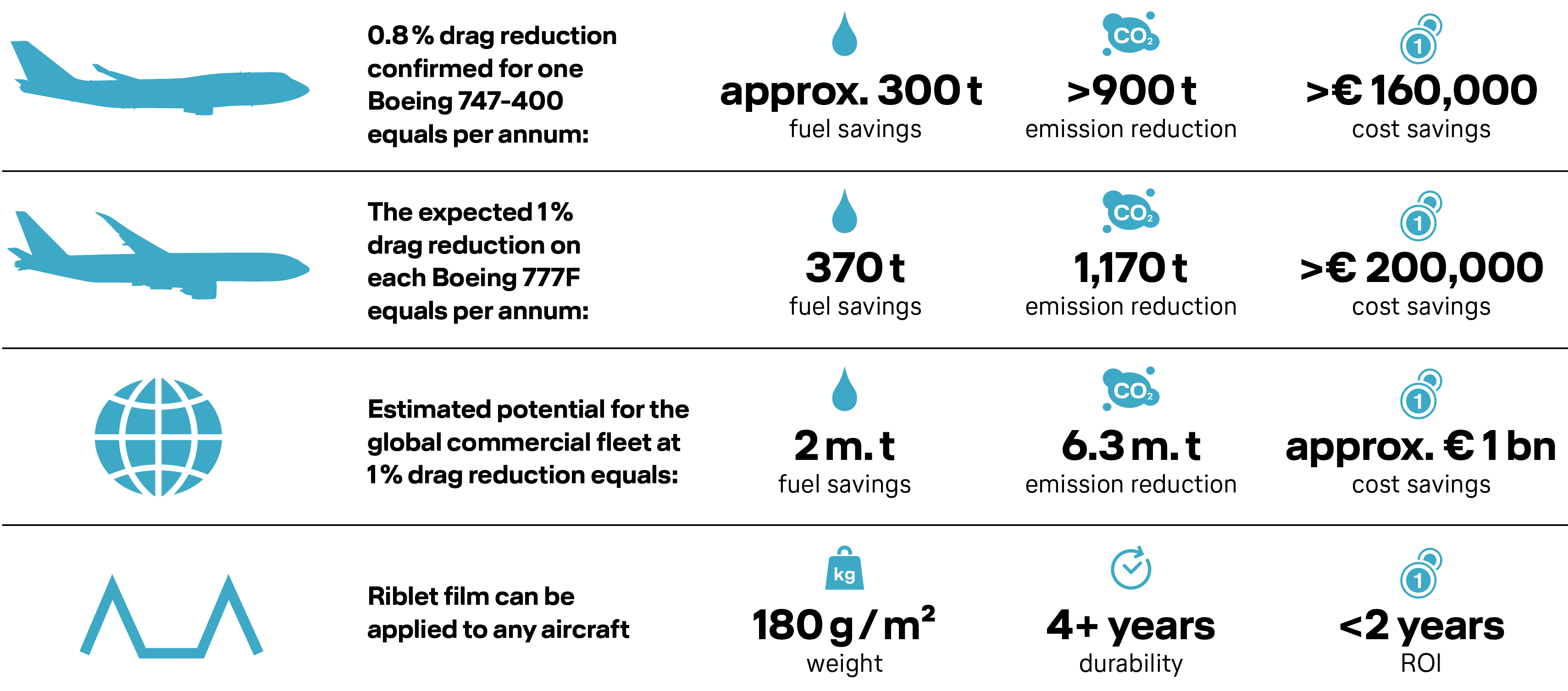The developed solution is entitled AeroSHARK and consists of adhesive bionic films that replicate the skin of sharks. The latter`s well-known efficiency is now used to optimize the airflow around the aircraft, thereby enabling significant fuel savings and emissions reduction.
AeroSHARK’s secret lies in the biomimetic film’s microscopic properties. It consists of a barely perceptible texture of small ribbed protrusions – the eponymous riblets. Sized in patches for easy and targeted application, the film has millions of these prism-shaped riblets, each one around 50 micrometers high. Applied to the aircraft in a specific manner and precisely aligned with the airflow, the riblets achieve efficiency gains by reducing skin friction and drag, similar to their counterparts in nature, and can also improve lift if attached on wings.
You are about to play a YouTube Video, if you confirm you accept the external YouTube resources.
AeroSHARK - Cutting emissions with sharkskin technology
The riblet film is easy to apply, even on large commercial aircraft – it has already been certified with up to 500 m2 on a Boeing 747-400's lower fuselage and belly fairing. It is extremely resilient, withstands large temperature shifts and pressure differentials as well as the ultraviolet radiation on high flight levels.
In 2022, SWISS became the first passenger airline in the world to deploy the new AeroSHARK aircraft skin technology to further reduce carbon dioxide emissions and fuel consumption in flight operations. By applying a total of 950 square meters of AeroSHARK riblet film to the fuselage and engine nacelle surfaces of a Boeing 777, fuel savings of approximately 1.1 percent can be achieved. This reduces annual fuel consumption by more than 4,800 metric tons and the total annual carbon dioxide emissions of the SWISS Boeing 777 fleet by up to 15,200 metric tons - equivalent to the amount emitted by some 87 long-haul flights from Zurich to Mumbai.
On February 3, 2023, the world's first cargo aircraft, a Boeing 777 freighter operated by Lufthansa Cargo, took off with the AeroSHARK film. Extrapolated to the entire 777 fleet, this means an annual saving of more than 4,000 tons of kerosene and almost 13,000 tons of CO2 emissions, which corresponds to around 53 individual cargo flights from Frankfurt to Shanghai.
The riblet technology can be adapted to all kinds of aircraft with a similar effect; hence Lufthansa Technik already plans to certify it for additional surfaces and aircraft types in the near future.
03.02.2023
First freighter modified with AeroSHARK enters scheduled service
Lufthansa Cargo's Boeing 777F will save about one percent in fuel and emissions in the future
16.12.2022
Learn from nature and save CO2: Lufthansa Group is the first airline group worldwide to equip aircraft with aerodynamic sharkskin film
Innovative AeroSHARK surface technology from Lufthansa Technik and BASF improves fuel efficiency and reduces CO₂ emissions
14.10.2022
AeroSHARK: inspired by shark skin
SWISS is the first airline in the world to use the innovative AeroSHARK technology in its passenger services, further reducing its CO2 emissions and fuel consumption.
03.05.2021
Nature as a role model: Lufthansa Group and BASF roll out sharkskin technology
From 2022, Lufthansa Cargo will equip all Boeing 777 freighters with AeroSHARK
We invite you to explore a selection of our established projects, initiatives, and ambitions
The Lufthansa Group CleanTech Hub is striving for technological excellence to tackle the challenges of climate change

